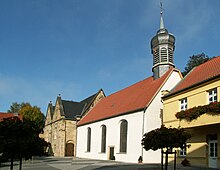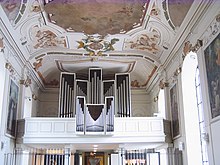St. John Baptist (Herford)
St. Johannes Baptist is the only Catholic inner-city church in the district town of Herford in East Westphalia-Lippe , North Rhine-Westphalia . Structurally, the church and parish belong to the Herford Pastoral Association in the Herford-Minden deanery of the Archdiocese of Paderborn . It was the church of the Johanniterkommende Herford .
history
Probably in the years 1230/31 a Johanniterkommende settled in the so-called Herford New Town , which Abbess Gertrud II. Had initiated to Lippe . The members of the Order of St. John and Knights of Malta took care of the sick in Herford and therefore received rich donations from the nobility and the citizens of Herford. The Coming therefore had goods near the city and free float. In the 14th century the Coming got into economic difficulties. Today's parsonage was built in 1468 as a new building for the commander.
With the Reformation , a large part of the population in Herford changed to the Lutheran creed. The few remaining Catholics used the Chapel of the Coming as a place of worship. In 1645, the Order of Malta won a legal dispute over the property rights to the church, so that from 1646 a Roman Catholic priest was again serving there. In 1674 the Maltese chapel was repaired.
After the death of commander Jacob van der Slart, Kommende Herford may have been co-administered by the commanders in Lage . Often they now use Protestant "administrators" for supervision.
In 1715 the Komtur von Schaesberg had the previous chapel replaced by a baroque hall church for the order. This is the older (eastern) part of today's parish church.
In 1808 the Coming of Malta was abolished as part of the secularization and the property was nationalized. In 1820 the Catholic parish of St. Johannes Baptist was established for the Catholics of the city of Herford and the surrounding area.
In 1890/91 a neo-Romanesque extension was built in the west of the church, in which the sanctuary also found its place, which has therefore since been, contrary to traditional practice, not in the east but in the west of the church. A newly created main entrance and a gallery were created in the east. The old baroque high altar was replaced by a copy of the Minden Golden Plate (see below). The altarpiece of the old high altar is still preserved.
In 1939, parts of the relics of Saint Pusinna , which had been banned from the Herford cathedral during the Reformation , were found in Heddinghausen , and they were taken to St. John's Church in 1949.
From 1949 to 1951 the interior of the church was renovated. During this time, the paintings on the ceiling and walls of the baroque part were renewed by a professor Thol in a baroque style. Between 1964 and 1969, the interior was redesigned as part of the liturgical reform . In particular, the altar, baptismal font and tabernacle were created . The last exterior renovation was in 1984 and the last interior renovation between 2006 and 2008.
The church has been a listed building since 1981 .
Furnishing
Baroque part
In the older baroque part there is a Pietà from the Osnabrück school on the east wall . It is a carving from the 16th century. Next to the organ are two more recent pictures that were taken in 1949/51. One shows Queen Mathilde , the mother of Otto the Great . She was brought up as the daughter of Saxon nobility around 900 in the Herford women's monastery. The other shows Saint Pusinna, whose relics were brought to Herford by Binson in France in 860 . From the overpass, Herford developed into a place of pilgrimage. The large ceiling painting shows the Assumption of Mary into heaven.
At the transition to the neo-Romanesque part hangs the former altarpiece of the Coming on the north wall. It shows the baptism of Jesus in the Jordan and was created in 1715. On the opposite side there is a group of guardian angels from the Baroque era. The baptismal font of the church is in the center aisle.
Neo-Romance part
The neo-Romanesque part has three naves and is therefore wider than the baroque one. The two side aisles contain various works of art: the new tabernacle is set up at the front end of the right aisle, and a wooden mission cross hangs above it . In the left aisle there is a statue of John at this point , which was created in the 19th century in the Wiedenbrück school . Opposite the tabernacle, a painting by Saint Sebastian commemorates Wilhelm Oberhaus , who died in 1942 in the Dachau concentration camp . On the north wall of the right aisle there is an epitaph for Theodor Thorwesten , who was administrator in the service of the Lords of Westphalia and a patron of the parish in the 17th century.
In the apse is the reredos of the former high altar. It is a copy of the so-called Minden Golden Plate (originally in Minden Cathedral , today in Berlin's Bode Museum ), which was made in 1891 by the sculptor Anton Mormann (1851–1940) (Wiedenbrück School), who was entrusted with the restoration of the original has been. Originally also present predella was after in the wake of the Second Vatican Council made liturgical reform eliminated and replaced at the last church renovation with a modern socket in which the relics of saints Pusinna are embedded.
In 1950 the neo-Romanesque part of the church received new windows. The right window shows scenes from the life of Mary, the left scenes from the life of the parish priest Johannes. The central window of the apse, however, is still historical and shows the enthroned Christ . It was temporarily walled up on both sides and was only rediscovered and exposed at the end of the 20th century.
organ
The organ was rebuilt in 1969 by the organ builder Gustav Steinmann . The slider chest instrument has 24 stops on two manuals and a pedal . The game contractures are mechanically, the Registertrakturen are electric.
|
|
|
|||||||||||||||||||||||||||||||||||||||||||||||||||||
- Coupling : II / I, I / P, II / P
Web links
Individual evidence
- ↑ List of architectural monuments in the city of Herford (PDF; 78 kB)
- ↑ Further information on the organ , accessed on September 4, 2014.
Coordinates: 52 ° 6 ′ 54.2 " N , 8 ° 40 ′ 35.6" E



